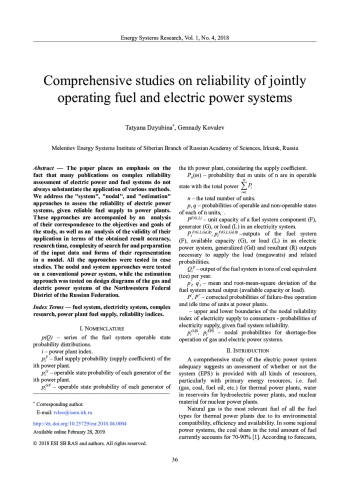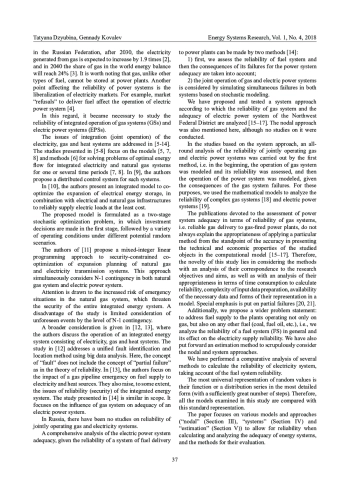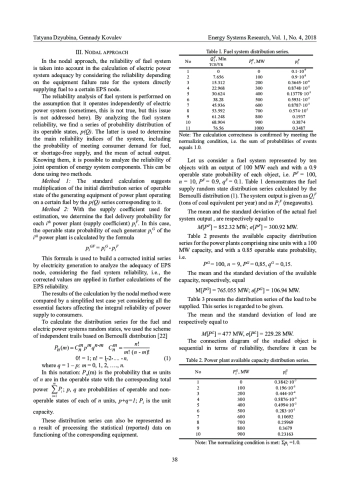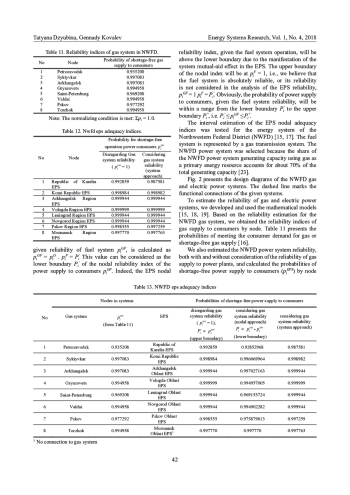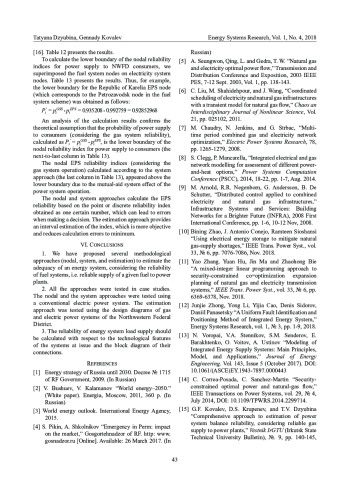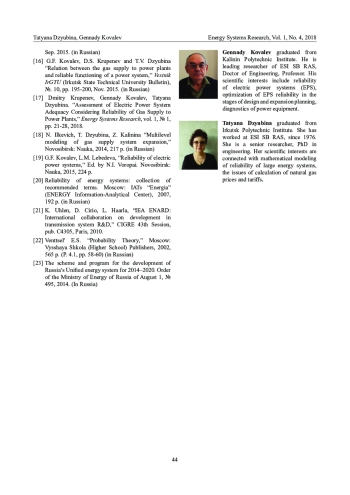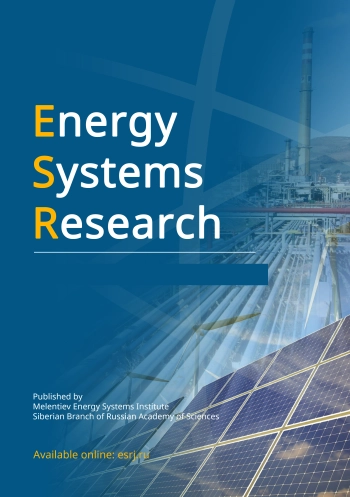The paper places an emphasis on the fact that many publications on complex reliability assessment of electric power and fuel systems do not always substantiate the application of various methods. We address the “system”, “nodal”, and “estimation” approaches to assess the reliability of electric power systems, given reliable fuel supply to power plants. These approaches are accompanied by an analysis of their correspondence to the objectives and goals of the study, as well as an analysis of the validity of their application in terms of the obtained result accuracy, research time, complexity of search for and preparation of the input data and forms of their representation in a model. All the approaches were tested in case studies. The nodal and system approaches were tested on a conventional power system, while the estimation approach was tested on design diagrams of the gas and electric power systems of the Northwestern Federal District of the Russian Federation
Идентификаторы и классификаторы
A comprehensive study of the electric power system adequacy suggests an assessment of whether or not the system (EPS) is provided with all kinds of resources, particularly with primary energy resources, i. e. fuel (gas, coal, fuel oil, etc.) for thermal power plants, water in reservoirs for hydroelectric power plants, and nuclear material for nuclear power plants.
Список литературы
1. Energy strategy of Russia until 2030. Decree № 1715 of RF Government, 2009. (In Russian).
2. V. Bushuev, V. Kalamanov “World energy-2050”. (White paper). Energia, Moscow, 2011, 360 p. (In Russian).
3. World energy outlook. International Energy Agency, 2015.
4. S. Pikin, A. Shkolnikov “Emergency in Perm: impact on the market”, Gosgortehnadzor of RF. http: www.gosnadzor.ru [Online]. Available: 26 March 2017. (In Russian).
5. A. Seungwon, Qing, L. and Gedra, T. W. “Natural gas and electricity optimal power flow”, Transmission and Distribution Conference and Exposition, 2003 IEEE PES, 7-12 Sept. 2003, Vol. 1, pp. 138-143.
6. C. Liu, M. Shahidehpour, and J. Wang, “Coordinated scheduling of electricity and natural gas infrastructures with a transient model for natural gas flow”, Chaos an Interdisciplinary Journal of Nonlinear Science, Vol. 21, pp. 025102, 2011.
7. M. Chaudry, N. Jenkins, and G. Strbac, “Multi-time period combined gas and electricity network optimization”, Electric Power Systems Research, 78, pp. 1265-1279, 2008.
8. S. Clegg, P. Mancarella, “Integrated electrical and gas network modelling for assessment of different power-and-heat options”, Power Systems Computation Conference (PSCC), 2014, 18-22, pp. 1-7, Aug. 2014.
9. M. Arnold, R.R. Negenborn, G. Andersson, B. De Schutter, “Distributed control applied to combined electricity and natural gas infrastructures”, Infrastructure Systems and Services: Building Networks for a Brighter Future (INFRA), 2008 First International Conference, pp. 1-6, 10-12 Nov, 2008.
10. Bining Zhao, J. Antonio Conejo, Ramteen Sioshansi “Using electrical energy storage to mitigate natural gas-supply shortages”, IEEE Trans. Power Syst., vol. 33, № 6, pp. 7076-7086, Nov. 2018.
11. Yao Zhang. Yuan Hu, Jin Ma and Zhaohong Bie “A mixed-integer linear programming approach to security-constrained co=optimization expansion planning of natural gas and electricity transmission systems”, IEEE Trans. Power Syst., vol. 33, № 6, pp. 6369-6378, Nov. 2018.
12. Junjie Zhong, Yong Li, Yijia Cao, Denis Sidorov, Daniil Panasetsky “A Uniform Fault Identification and Positioning Method of Integrated Energy System”, Energy Systems Research, vol. 1, № 3, pp. 1-9, 2018.
13. N. Voropai, V.A. Stennikov, S.M. Senderov, E. Barakhtenko, O. Voitov, A. Ustinov “Modeling of Integrated Energy Supply Systems: Main Principles, Model, and Applications”, Journal of Energy Engineering. Vol. 143, Issue 5 (October 2017). DOI: 10.1061/(ASCE)EY.1943-7897.0000443 EDN: YSVDGR
14. C. Correa-Posada, C. Sanchez-Martin “Security-constrained optimal power and natural-gas flow”, IEEE Transactions on Power Systems, vol. 29, № 4, July 2014,. DOI: 10.1109/TPWRS.2014.2299714
15. G.F. Kovalev, D.S. Krupenev, and T.V. Dzyubina “Comprehensive approach to estimation of power system balance reliability, considering reliable gas supply to power plants”, Vestnik IrGTU (Irkutsk State Technical University Bulletin), №. 9, pp. 140-145, Sep. 2015. (in Russian). EDN: UJWFMB
16. G.F. Kovalev, D.S. Krupenev and T.V. Dzyubina “Relation between the gas supply to power plants and reliable functioning of a power system”, Vestnik IrGTU (Irkutsk State Technical University Bulletin), №. 10, pp. 195-200, Nov. 2015. (in Russian). EDN: VCPCTF
17. Dmitry Krupenev, Gennady Kovalev, Tatyana Dzyubina. “Assessment of Electric Power System Adequacy Considering Reliability of Gas Supply to Power Plants”, Energy Systems Research, vol. 1, № 1, pp. 21-28, 2018. EDN: UVIOWF
18. N. Ilkevich, T. Dzyubina, Z. Kalinina “Multilevel modeling of gas supply system expansion”, Novosibirsk: Nauka, 2014, 217 p. (in Russian). EDN: TTFXYJ
19. G.F. Kovalev, L.M. Lebedeva, “Reliability of electric power systems”, Ed. by N.I. Voropai. Novosibirsk: Nauka, 2015, 224 p.
20. Reliability of energy systems: collection of recommended terms. Мoscow: IATs “Energia” (ENERGY Information-Analytical Center), 2007, 192 p. (in Russian).
21. K. Uhlen, D. Cirio, L. Haarla, “IEA ENARD: International collaboration on development in transmission system R&D”, CIGRE 43th Session, pub. C4305, Paris, 2010.
22. Venttsel’ E.S. “Probability Theory”, Мoscow: Vysshaya Shkola (Higher School) Publishers, 2002, 565 p. (P. 4.1, pp. 58-60) (in Russian).
23. The scheme and program for the development of Russia’s Unified energy system for 2014-2020. Order of the Ministry of Energy of Russia of August 1, № 495, 2014. (In Russia).
Выпуск
Другие статьи выпуска
An increase in service life of equipment and plants (objects) in electric power systems makes it more appropriate to relate the organization of a system of maintenance service and restoration of wear and tear to their technical condition. This, in turn generates the need to quantitatively estimate the indices of their individual reliability. There can be no data on failures and defects of concrete objects, therefore, in practice we often calculate generalized reliability indices. An intuitive understanding of the varied significance of varieties of attributes is reflected by classifying statistical data for some varieties of attributes. For example, they can be classified according to voltage class, design, service life, etc. At the same time, the question on the appropriateness of the statistical data classification is not considered. Initial assumptions of known methods and criteria of checking if it is expedient to classify the statistical data on failures of the electric power system objects in most cases are unacceptable, since they are not relevant to this data set. We have developed a new method and an algorithm to assess the appropriateness of the statistical data classification. Their novelty lies in the application of a fiducial approach to estimation of critical values of a sample from a set of multivariate statistical data.
The paper presents an option for determination of phase loads in the primary distribution network using the results of state estimation of the secondary distribution network that are obtained by smart meter measurements installed at the load and generator nodes. The problem of state estimation in the secondary distribution network based on measurements of the active and reactive nodal powers and voltage magnitudes rather than by the Newton method traditionally used for this purpose is solved by a method of simple iterations. Efficiency of using the proposed approach for determination of phase loads of the primary distribution network for each hour of daily curve of nodal powers is illustrated by the example of a 32-node test network.
The paper focuses on the probabilistic evaluation of oil and gas resources with the models and methods of AHP/ANP analysis. The AHP/ANP models are shown to be the particular cases of finite Markov chains, i. e. discrete random processes with Markov property. An integrated method (Markov expert logical analysis (МELA)) is proposed. The method is based on the models, methods and algorithms of Markov chains theory. This basis will stimulate the progress in research on multi-criteria decision-making problems that arise in various spheres. The paper presents different methods using MELA to allow for the uncertainty of numeric and nonnumeric data on gas reserves as methods of transformation of expert estimations into the probability distributions. Typical logical schemes are proposed for multi-criteria comparison of analogous objects, to take account of possible errors in porosity evaluation and to estimate project life.
The paper analyses the role of the Asia Pacific Region and East Asia, in particular, for both Russia and Mongolia as energy exporters. A quantitative assessment of coal, oil and natural gas markets demand of East Asia countries is made. The assessment relies on our outlook, and the outlooks of Russian and foreign organizations. The prospective directions of energy cooperation between Russia and Mongolia, which allow harnessing the resource, geographical and economic potential of the two countries and expanding energy cooperation with the other countries in East Asia, are proposed.
The paper is concerned with the numerical simulation of the coal gasification process in an entrained flow of high-temperature air-steam mixture. Due to the high initial temperature and the process staging, it is possible to obtain an efficient gasification process. The study aims to examine the stationary conditions of staged gasification process by using a mathematical model based on one-dimensional heat and mass transfer equations with combined submodels to describe physicochemical transformations. The simulation makes it possible to determine the boundaries of the transition from the “single-stage” to the “two-stage” gasification conditions and identify the most promising ones.
The paper presents the background of creation and development of Mongolia’s electric power industry and its current state. Despite considerable energy resources, the country suffers from electric power shortage that is covered by electricity supplied from Russia and China. The expected considerable power consumption growth can be met by doubling generating capacities, enhancing electrical networks and by interconnecting the five existing electric power systems (EPSs) into an Integrated Power System (NPS) of Mongolia as a future component of the Northeast Asian Super Grid. To accomplish these tasks, we propose a number of conceptual structural and technological models for the development of Mongolian electric power systems that can form a basis for the future Integrated Power System of Mongolia.
The progressing distribution of the electricity supply necessitates redesigning the mechanism for providing ancillary services particularly by the distribution grid. Methods of voltage regulation and congestion management particularly have to satisfy new standards since, although the development of renewables is increasing the number of resources with an impact, these resources’ individual contribution is comparatively slight. Taking the state-of-the-art and the basic regulatory conditions in Germany as a point of departure, this paper analyzes the requirements for algorithms and communication systems that provide distributed support to distribution grid operation. A novel mathematical method that prevents voltage range deviations and feeder overloads based on sensitivities is presented and validated in simulations by a case study. An analysis of the communications systems for monitoring and control technologies for distributed energy resources, including the available communication channels, serves as the basis for an evaluation of the suitability of current control mechanisms in the future. The findings of a live field test in a real 110 kV distribution grid corroborate the necessity for coordinated grid support by distributed energy resources and demonstrate the limits of current methods.
Статистика статьи
Статистика просмотров за 2025 - 2026 год.
Издательство
- Издательство
- ИСЭМ СО РАН
- Регион
- Россия, Иркутск
- Почтовый адрес
- 664033, Иркутская область, г. Иркутск, ул. Лермонтова, д. 130.
- Юр. адрес
- 664033, Иркутская область, г. Иркутск, ул. Лермонтова, д. 130.
- ФИО
- Стенников Валерий Алексеевич (Руководитель)
- E-mail адрес
- info@isem.irk.ru
- Контактный телефон
- +7 (395) 2500646
- Сайт
- https:/isem.irk.ru

